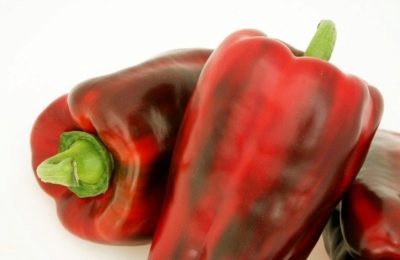
- Authors: DEGREEF PAUL
- Name synonyms: Pompeo
- Year of approval: 2014
- Bush height, cm: up to 100
- Growth type: medium-sized
- Fruit shape: cylindrical
- Fruit weight, g: 150-280
- Fruit color: green in technical ripeness, red in biological ripeness
- Ripening terms: mid-season
- Ripening month: August, September, October
Seasoned gardeners know that varieties from Holland are usually unpretentious in care and perfectly adapt to different weather conditions. Pompeo F1 is one of the high-yielding hybrid pepper varieties, developed in 2011 by Dutch breeders. And already in 2014, it was entered in the State Register and approved for cultivation in the territory of the Russian Federation.
Description of the variety
Pepper of the Pompeo variety has not so long been used by domestic vegetable growers, but has already earned a lot of positive reviews. The culture was appreciated due to its many pluses:
- high productivity;
- extended period of fruiting;
- cold and drought resistance;
- strong immunity to most ailments of culture;
- unpretentiousness;
- the presence of thick walls;
- great taste;
- high marketability;
- versatility.
All hybrids have one drawback - the inability to use seeds from their own site.
Characteristics of the appearance of plants and fruits
Pompeo's standard densely leafed bush is medium-sized, grows up to a meter. Average spreading. The leaves are large, in the form of an ellipse, with wrinkles. The arrangement of the fruits is drooping. The pepper is in the shape of a cylinder. Very large, weighing from 150 to 280 grams, with a wall thickness of 5-6 mm. Green at the stage of technical maturity, and when biological ripeness comes, it becomes red, glossy. There are 3-4 nests inside the fruit. The fruits are attached to the branches by a long stalk, differing in thickness.
Purpose and taste
Product application is universal. Sweet peppers are used both for preservation and for freezing. Fresh sliced peppers are delicious in summer salads. It can be used to prepare hot dishes, side dishes. Medium sized peppers are especially good for stuffing. For the winter, they can still be pickled, and also added to lecho.
Ripening terms
The Pompeo hybrid is a mid-season crop. Technical ripeness is reached 95-110 days after the seeds have sprouted, biological - after 7-10 days. Long-term fruiting.
Yield
The yield of the Dutch hybrid variety is quite high. On average, 20-25 kg of fruits or 292-318 c / ha are removed from 1 m2.
Growing regions
Zoned hybrid for growing in open beds in the North Caucasus and the Lower Volga region. But the scope of its distribution was not limited to these territories. Today, Dutch pepper is successfully cultivated in private greenhouse farms in the central and northwestern regions of the country, there have been cases of obtaining a stable harvest in the Urals, in areas of risky farming, for example, in the western part of Siberia.

To get a large and tasty harvest of pepper, you need to take care of the seedlings in advance. When growing pepper seedlings, you need to correctly determine the sowing time, pre-sowing seed treatment, prepare the necessary container and soil.
Growing and care
In the central regions, the hybrid in question is grown through seedlings.This makes it possible to get the first harvest after July 15th. Planting seed should be planned for the last days of February or early March. In this case, the seedlings will be ready for transplanting after May 20. In principle, anyone, even an absolute beginner, can grow a sweet Pompeo pepper. The main thing is to carry out the basic care measures:
- water in moderation, while it is important to increase the amount of watering at the stage of fruit ripening;
- alternate feeding with organic matter and complex mineral fertilizers;
- do not forget about loosening and weeding the beds.
The Pompeo hybrid will produce excellent fruit in an open area, sunlit, with protection from the wind. The soil should be loose as well as fertile.
Important: you cannot plant seedlings of sweet and spicy peppers nearby. In this case, pollination will occur, the sweet pepper will become with a bitter aftertaste.
The hybrid variety Pompeo is characterized by rather high commercial performance. Vegetables can be removed at the stage of technical maturity, they can ripen perfectly indoors, where it is cold and dark.

To harvest a tasty and rich harvest of pepper, you need to comply with all the conditions of agricultural technology, and proper care begins with planting plants. Before planting pepper in open ground, it should be prepared. It is also important to take care of the seedlings and planting space in advance.




For good growth of pepper bushes and active fruiting, you need to regularly apply mineral and organic fertilizing to the soil. It is necessary not only to choose the right formulations, but also to use them at the right stage in the development of culture. The frequency of top dressing is always individual. It depends directly on the composition of the land on your site. The poorer the soil composition, the more often you will need to feed the pepper.
Disease and pest resistance
The originators promise that the Pompeo hybrid is highly resistant to diseases such as top rot, tobacco mosaic virus (TMV), and spotted wilting virus. However, if the weather is cold and damp, the culture is sometimes affected by such ailments as powdery mildew, as well as late blight. For the prevention of these infections, it is worth treating the peppers with the "Fitosporin" solution. According to gardeners' reviews, pests show almost no interest in the pepper of the described variety.

Pepper is one of the most common vegetables in home gardens. This culture is quite stable and unpretentious. However, under certain conditions, this plant can suffer from infections and harmful insects. Before treating peppers for diseases or pests, you need to find out the cause of the problem, otherwise the treatment may be ineffective.





















































































